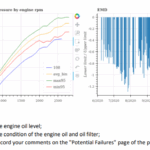Slide 1. Introduction.
The class discusses what the cooling system is, its maintenance, and its implications for fleet management.
Slide 2. Vehicle's cooling system.
- How the engine cooling system works.
Extreme temperatures are the most dangerous enemies of a vehicle and its components, so it is essential to understand the purpose of the engine cooling system if we want to extend its useful life and avoid costly breakdowns.
This system, composed of several parts that help dissipate excess heat, has a critical function: to maintain the engine temperature within the correct operating range, around 90°C. The cooling system is made up of several parts that work together: the radiator, the water pump, the thermostat, the hoses, and the reservoirs. Its ultimate goal is simple: to prevent the engine from overheating.
The coolant circulates through internal ducts, absorbing the heat generated by combustion and friction between parts. Once it passes through the radiator, the outside air cools it so that it can return to the circuit. The thermostat regulates the flow and the water pump provides the necessary force to propel it.
- Main components of the system.
- Radiator.
This is a heat exchanger that cools the liquid using the air that enters through the car's grille.
- Water pump.
This moves the coolant around the cooling circuit. It usually works mechanically, as it is connected to the engine via a belt or gears. However, the trend in more modern cars is to use electric pumps. In order to prevent breakdowns and improve the cooling circuit, vehicles currently leaving the dealership usually include, in addition to the main pump, other auxiliary electric pumps that continue to cool the engine even after you have finished your journey and left the car parked. This helps to preserve the parts inside the block and prevent them from warping.
- The thermostat.
Regulates the flow of liquid, opening or closing the circulation to the radiator depending on the temperature.
The thermostat is usually located inside the block or in a thermostatic box. It consists of a spring and a membrane. Depending on the temperature of the engine block, it allows the coolant to flow to the radiator or simply circulates it within the block to maintain a constant operating temperature of 90°C.
- Hoses and reservoirs.
Connect the different elements and store excess coolant in the expansion tank.
- Cap and valves.
Maintain pressure within the circuit and release liquid if it becomes too high.
- Cooling system operation.
If the vehicle is cold and has not reached operating temperature, the thermostat remains closed. At this point, the pump only recirculates the coolant through the various engine channels.
When the vehicle reaches 90°C, the thermostat opens and the coolant passes to the radiator to cool down and return to the engine block.
Once cooling is achieved, the thermostat closes again and the coolant circulates back inside the engine with the help of the pump. The interesting thing about this whole process is that the heat generated by the engine is not expelled directly to the outside, but is used for heating.
- Do electric cars have a cooling system?.
Yes, they have a cooling circuit, but obviously it is not for the engine, which is electric, but for the batteries. The circuit is very similar to that of combustion engines: an electric pump circulates the liquid from the expansion tank to the radiator and, from there, to the batteries to cool them. A thermostat is no longer necessary here.
- And in the case of hybrid cars, what cooling system do they have?.
Manufacturers usually install up to two cooling circuits: on the one hand, the combustion engine cooling system, and on the other, the circuit for the batteries. Both systems are very similar and have the function of cooling different elements of the hybrid car.
Slide 3. Engine cooling system maintenance.
- Risks of not keeping the system in good condition.
A neglected system can cause serious breakdowns such as:
- Gaskets damaged by excessive heat.
- Pistons and cylinders deformed by extreme temperatures.
- Breakage of the water pump or thermostat, causing sudden overheating.
- High repair costs, which in extreme cases may require a complete replacement of the engine block.
In addition, many drivers face a common problem: the car loses coolant, but does not overheat. This may be due to small leaks in the hoses, expansion tank, or radiator. Although overheating does not occur immediately, it is a clear sign that something is wrong and should be checked.
- Tips for preventive maintenance of the cooling system.
- Check the coolant level periodically. It should always be between the minimum and maximum marks.
- Check the condition of the hoses to ensure they are not cracked or leaking.
- Change the coolant according to the manufacturer's instructions, normally every two to five years.
- Clean the radiator to remove dirt, dust, and debris that may obstruct airflow.
- Pay attention to the coolant level warning light on the instrument panel. Ignoring it can lead to overheating or more serious damage.
- Listen to the engine: strange noises or sudden temperature rises usually indicate a fault in the thermostat or water pump.
-
- When to replace system components.
Although good maintenance extends the life of the system, there are parts that sooner or later need to be replaced:
- Water pump: usually lasts between 100,000 and 150,000 km, although it is advisable to check it when changing the timing belt.
- Thermostat: if it gets stuck, open or closed, the car will have temperature problems.
- Radiator: over the years, it can suffer from leaks or internal corrosion.
- Hoses and caps: these should be replaced if they show signs of wear or loss of pressure.
- Comparison of symptoms and possible causes.
|
Symptom |
Possible cause |
|
It loses coolant but does not heat up. |
Leak in hoses, expansion tank or radiator. |
|
Coolant warning light on. |
Low level, faulty sensor or leak in the system. |
|
The engine heats up quickly. |
Stuck thermostat or faulty water pump. |
|
White smoke from the exhaust. |
Damaged cylinder head gasket or coolant in cylinders. |
|
Sweet smell in the cabin. |
Internal coolant leak in the heating radiator.
|
- Implications for fleet management.
The main consequence is the cost of the breakdown and the time the vehicle is down without service.
The cooling system is very important because a breakdown can cause a very high temperature rise in the engine, which can cause seizure, rendering it unusable and requiring a new engine, at a high cost.
Preventive maintenance of the cooling system must be performed according to the manufacturer's instructions and within the timeframe recommended by the manufacturer.
It is recommended to use antifreeze rather than water because it has more advantages.
It is recommended to use original spare parts or those from premium spare parts companies.
It is recommended to carry a bottle of antifreeze in the vehicle in case the cooling system needs to be refilled.
Many modern vehicles don't have an engine temperature thermometer on the dashboard. When the temperature rises, the engine warning light comes on, but if we don't know the cause, it's recommended to stop the vehicle and contact the fleet manager or workshop manager.
If you add either antifreeze or water while the engine is hot, do so while it is running. If the engine is hot and you add water while it is stopped, the temperature difference will most likely cause the cylinder head to warp, rendering it unusable. Therefore, you will need to install a new cylinder head or rework it.
Drivers should be trained to turn off the engine when the engine temperature rises, check the coolant level, and if you need to add water, follow the instructions outlined in the previous paragraph.
In short, the engine cooling system is key to extending the life of your car and avoiding breakdowns that can cost over a thousand euros. Monitoring for leaks, paying attention to any signs of engine failure, and performing regular checks are simple measures that will save you from more than one serious breakdown.
Slide 3. Thank you for your time.
The class has covered the cooling system, its maintenance, and its implications for fleet management. See you soon.
Download the audio




















